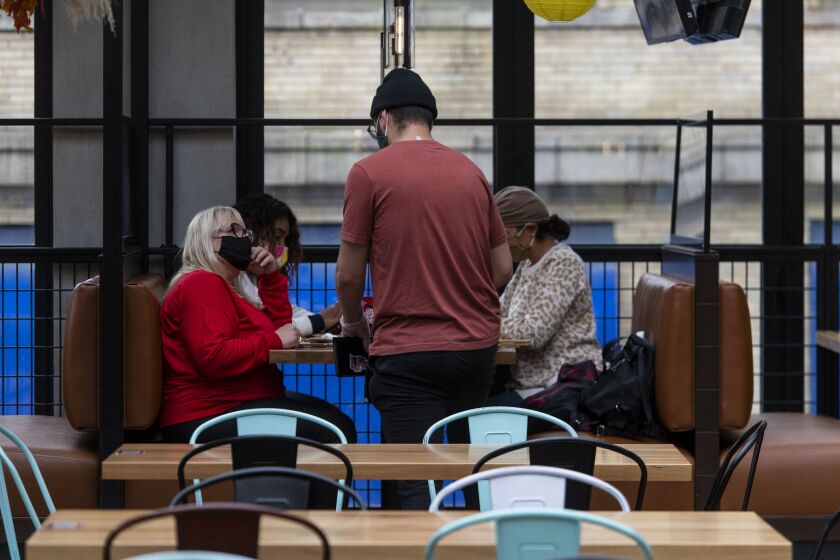Scott Weiner, who runs 20 restaurants in Chicago, feels like a scapegoat in a pandemic.
Like other operators, he sees a real possibility that the city’s bars and restaurants may be forced to completely shut down because of the rising number of COVID-19 cases. He’d also like to see proof that his businesses, which include Roots Handmade Pizza and West Town Bakery, are contributing to the problem.
“On top of poor data, you get the feeling people are making decisions without really knowing,” said Weiner, co-owner of the Fifty/50 Restaurant Group.
Government data are at the center of confusion about safety of restaurants and bars as coronavirus cases are on the rise. On Friday, a defensive Gov. J.B. Pritzker said “bars and restaurants are super spreader locations,” a term that makes those in the industry cringe because they say there is no conclusive proof. Pritzker has shut down indoor restaurant dining in DuPage, Kane and Will Counties as well as other parts of the state.
This week, the governor’s office provided a chart showing that in August and September 2,300 confirmed coronavirus patients had visited a restaurant or bar in the previous two weeks. While those establishments make up the largest category of places visited by those infected during that two-month period, the numbers don’t definitively say that those people contracted the virus at a specific bar or restaurant. State officials say one of the problems in compiling data is how hard it is to trace infections back to an exact location, an assertion also made by some local health departments.
While the state said its data reflects from 69 of 97 counties in Illinois, Chicago and Cook County have not publicly provided detailed figures on risk associated with bars and restaurants here.
Part of the problem — or solution?
“I don’t want to see the restaurant industry labeled as super spreaders because that’s not true,” said Adam Gewanter, managing partner of TAO Chicago in River North. Like Weiner, he’d like to see proof. “As far as the data are concerned, I’d love to read it.”
TAO, which has not seen an outbreak, requires masks, takes temperatures of customers and sanitizes, said Gewanter said, who expects more than 400 customers Saturday.
“Our goal is to be part of the solution — not part of the problem,” he said.
The city has temporarily closed more than 50 businesses, mostly bars and restaurants, for COVID guideline violations.
On Monday Mayor Lori Lightfoot defended her decision late last month to loosen restrictions on bars. But on Wednesday, with cases spiking higher in the city, she imposed tighter rules, shortening restaurant hours, mandating a 10 p.m. close and a 9 p.m. cutoff for alcohol sales. Bars are prohibited from indoor seating.
When asked for numbers showing risk, Lightfoot’s Public Health Commissioner Dr. Allison Arwady said that the city doesn’t have them but provided anecdotal evidence of a couple of gatherings of people at bars that are being investigated as outbreaks.
Expert: Most risk from your friends
Experts say restaurants and bars aren’t inherently dangerous places. Rather, the interactions between friends face to face without masks for longer periods of time increase the chances of spread.
“What’s happening is people are meeting up with other people who they haven’t seen in a while,” said Dr. John Schneider, medical director for the 55th Street clinic at Howard Brown Health. “It’s not the random family that goes out for Sunday night dinner. But you do see a lot of young people who are getting together and socializing.”
Workers in cramped kitchens are at far more risk than customers, he added. Mask wearing and social distancing can make establishments safe but it depends on the customers.
“The risks at bars and restaurants are really who you are going with,” Schneider added, saying people in those settings are likely to catch the virus from contacts they know.
Outside Chicago, Cook County is keeping an eye on restaurants, said Dr. Rachel Rubin, senior medical officer for Cook County Department of Public Health. “Everything is on the table,” she said, referring to further restrictions.
DuPage County health officials provide some of the most granular data available on dining and COVID infections but only as a subset of the total cases, which are more than 21,000 in the county. From March 1 to October 20, DuPage County recorded five virus outbreaks leading to 22 cases of infection tied to dine-in restaurants. Those cases make up less than 1 percent of the 3,135 infections tied to outbreaks, which is defined as two or more infections at one location.
In Lake County, 5 percent of cases in the past month were attributed to restaurant employees, while more than three quarters were attributed to long-term care facilities, a health department spokeswoman said.
Asked if restaurants and bars are safe, the department responded: “If people observe proper social distancing, wear face coverings, frequently wash their hands and avoid touching their face in any setting, they significantly reduce the likelihood of transmission.”
Brett Chase’s reporting on the environment and public health is made possible by a grant from The Chicago Community Trust.






